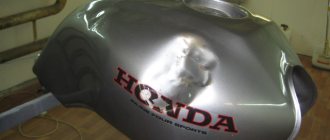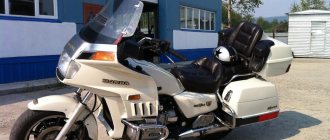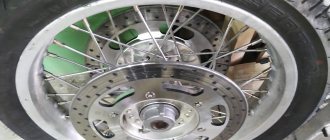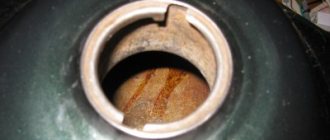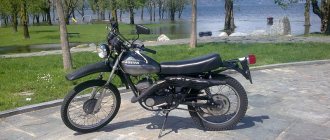The last warm days are coming to an end and it’s time to think about storing your motorcycle for the winter. Unfortunately, motorized vehicles, unlike four-wheeled vehicles, are not suitable for traveling on icy and snowy roads. Many insufficiently responsible motorcyclists without any hesitation leave their horse to spend the winter in a parking lot or in an unheated garage without prior preparation. It is worth understanding that this approach is fundamentally wrong. At low temperatures and changes, the bike's systems deteriorate and subsequently the service life of the vehicle will be much shorter.
This article is dedicated to responsible owners who are ready to approach the wintering of their iron friend with great care. Considering that most garages still do not have heating, we will talk about preserving the motorcycle for the winter and storing it in an unheated garage. Below you will find answers to the following questions:
- How to preserve a motorcycle for the winter?
- What details should you pay attention to?
1). General preparation of a motorcycle for winter
A motorcycle, like any other equipment made of metal, really does not like dirt. To prevent the paintwork from fading and premature oxidation of metal surfaces, that is, rusting, it is necessary to wash the motorcycle clean before long winter storage, let it dry, then wipe it dry and treat it with polish.
Ten (10) Strangest Motorcycles Ever Built
It is necessary to wash the motorbike with warm water with the addition of a special cleaning agent that removes dirt, oil and grease. At the same time, it does not damage the paintwork of the equipment. There are many similar car and motorcycle wash products on the Internet that are suitable for your car or motorcycle.
Please note that it is advisable to wash the equipment directly at the place of its future storage, otherwise your work may be in vain, because dirt can still get on the paint during transportation, and it can ultimately lead to a source of corrosion.
After washing, the motorcycle must be treated with polish. This way you will create an artificial moisture barrier. Finally, treat any exposed metal surfaces with WD-40 to dislodge any remaining water and make them more resistant to corrosion.
Some nuances
So, nowadays lawyers are often asked questions regarding movement on a vehicle such as a motorcycle. In particular, this concerns the management of this transport in the winter season. Is it possible to ride a motorcycle in winter? Traffic regulations currently do not prohibit this. In other words, from the point of view of the law, riding a bike in winter, like driving a car, is allowed. But is it safe? Unfortunately no. Because the motorcycle does not have good grip. Despite the fact that stores now have a large selection of studded tires for this vehicle, it is better to wait until spring. It's safer this way.
Is it legal to ride a motorcycle in winter? What documents are required for this? As it was written earlier, traffic rules allow riding a motorcycle even in the cold season. The main thing is to follow the traffic rules. You must have a driver's document with you that allows you to ride a motorcycle, and insurance. This should not be forgotten.
Is it possible to ride a motorcycle in winter in Russia? Yes, according to traffic rules, driving such a vehicle in cold weather is not prohibited. However, operating a motorcycle in winter will cost significantly more than using a car. Therefore, it is worth considering whether this is necessary. After all, to use a motorcycle in winter you will need to purchase special equipment and, moreover, install new parts on your “iron horse”. All this is quite expensive. For example, in winter you will need to install a windshield on your motorcycle, heated steering wheel grips, and also purchase studded tires. Therefore, driving a bike in the cold season is not a cheap pleasure; not everyone can allocate funds from the family budget just to experience the pleasure of extreme driving on an icy road. Moreover, it is unsafe.
2). Changing oil and filters
Changing the oil and filters is extremely important for the lubrication system. It is much better to have fresh oil and new filters in it if the motorcycle will not be used for several months. By replacing new oil, you will prevent system blockages and dangerous oxides, cleanse the entire system of unnecessary toxins with this oil and increase the protection of the engine itself. It is advisable to change the oil in the fall for one more reason, but for this reason, would you want to change the oil at the very beginning of the season, when your hands are already itching to start your motorcycle and ride faster? You probably won't want to? That's it!
General rules
Any equipment, including walk-behind tractors, is prepared for winter according to certain rules. Preservation of the unit begins with its thorough cleaning. You cannot leave the product all in the dirt and soil. After cleaning, you need to dry everything thoroughly, because moisture can ruin the parts on which rust will appear.
Inspect all parts for wear and overall serviceability. If necessary, replace with new ones. If there is water on the elements, it will simply freeze in winter and ruin the entire system. Do I need to drain gasoline and oil? With gasoline, things are very simple - you just need to drain it or fill it with new one. But with oil it will be more difficult. It needs to be replaced with a new one or the old one filtered out if it does not contain a large amount of sediment. Don't leave your equipment without oil.
All cutting parts of tools must be carefully sharpened. Check the power cord and replace it if necessary before spring arrives. With these recommendations, you are unlikely to have problems with technicians in the spring.
4). Prepare the fuel system
Fill the tank with gasoline until the tank is full so that there is almost no air in it, as condensation may appear there and the tank will gradually begin to rust. Add fuel stabilizer to gasoline. Before the new season, it is better to drain this “old” gasoline and refuel with new one.
5). Protect your battery
Any rechargeable battery has a tendency to self-discharge; the battery will discharge especially quickly if it is not disconnected from the power circuit itself.
Charge the battery so that it retains its charge. Try to recharge the battery once a month.
IMPORTANT! Don't let the battery drain completely!
6). Preserve your tires for the winter
Tire storage is another important point in our tips. If you leave the motorcycle on a stand and it stands for a long time in the same place, then the tires themselves will be pressed through at the point of contact with the surface on which the motorcycle was standing. To prevent this from happening, there are two options. First, you need to buy special stands for the front and rear wheels. The second, preferable option, is to remove the wheels and take them home, and then store them at home, but only in a lying position. At the same time, the motorcycle itself without wheels must be placed in such a way that its suspension is not completely unloaded and the fork legs do not come completely out of the pants. This will prevent possible suspension problems in the future.
Materials and tools you will need to preserve your bike
Before you start preserving, you will have to do some shopping. This cannot be avoided even if the motorcycle is stored in a warm garage, because the bike will have to sit for at least 3 months, while its parts may simply become corroded due to moisture in the air. The main purpose of conservation is to eliminate moisture and dirt, as well as to preserve internal parts from corrosion.
For this you will need:
- special shampoo for washing vehicles;
- Silicone Grease;
- spray for metal surfaces WD-40 or any other equivalent;
- pump;
- chain lubricant;
- new motor oil;
- rags or any dense material for the plug;
- gasoline by tank volume;
- waterproof cover;
- wax polish or simple lubricant;
- polish for plastic.
It is necessary to choose only high-quality materials from well-known manufacturers. The packaging of lubricants must be preserved, because if the product was left open for a long time, its consistency and physical and chemical properties could change.
As a result, when low-quality or damaged materials are applied, they are not able to fully protect parts from corrosion.
7). Check antifreeze
If you will be storing your motorcycle in a place where temperatures may drop below zero, be sure to check the antifreeze level in the cooling system. It is very important! If you fill it with water, you may find a cracked cylinder block when you come to pick up your bike in the spring!
8). Don't let small animals ruin your motorcycle
Small rodents and other animals, as you and I know, love secluded corners. It is not uncommon for them to sneak into exhaust pipes or build houses out of air filters. Stop them from doing this! Place the plugs on the most critical areas of the motorcycle, namely the exhaust pipes and air intakes. It is important that these plugs (this can be a thick piece of cellophane or a rag) are of bright colors, so that when you come in the spring to prepare the bike for departure and try to start it, you forgot to take them off.
3). Lubricate moving parts and contacts
Using a spray lubricant, treat all connectors, as well as electrical components and rubber caps. In the first case, you will prevent oxidation of the contacts, and in the second, the rubber products will not dry out.
Be sure to lubricate the chain drive on your motorcycle, as well as the controls, fork surface, and support points.
10). Choosing storage space
A heated garage is best suited for storing such equipment (motorcycles). It is desirable that the temperature in it be uniform, around 10 -15 C. There should be no changes, much less sudden ones, in the bike storage room. They cause moisture to appear on the surface of the motorcycle, which can ultimately lead to rust.
Some bikers who do not have a garage store their motorcycles right at home. It is better not to resort to such extreme storage methods. Still, from the point of view of fire safety, storing a motorcycle in the house is not the best option, you never know what can be dropped on it, and lubricant or fuel flares up, as you know, instantly. Moreover, the motorcycle itself, even a motocross thing, is quite cumbersome, and do not doubt that it will definitely get in the way of the household.
What a garage should be like. One prerequisite
It is extremely important to keep the garage dry and to prevent moisture from entering the garage, either from above or below. If there is moisture in the garage, for example, the roof is leaking, or water is penetrating from below, such storage will negatively affect the condition of the car
It’s better for her to just stand on the street than to be in a wet, unventilated garage.
The worst option for storing a car in the garage in winter is a shell that sits in a damp place. The location in which the garage is located is of great importance. It is advisable to choose hills where moisture does not accumulate below.
Have you decided to store your car for a long time, all winter, but don’t want to put it in the garage? Then at least find a parking space for your car, preferably a guarded one. Leaving the car in the yard is a bad choice, since such a “snowdrop” will annoy everyone, taking up a parking space and interfering with cleaning.


